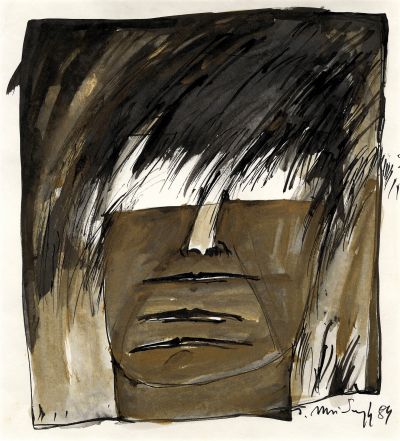Janina Musiałczyk. W drodze, on the road
Mediathek Sorted




































































































The dream of the lost suitcase
The founding of an independent art school in 1985, even before she finally settled in Hamburg-Volksdorf, gave Musiałczyk the prospect of fulfilment as well as a new goal in her life. From that time on, she not only built “a bridge to art” for children and adolescents, but also for adults, some of whom attended her classes in drawing, painting and composition for up to two decades, while others started their artistic career there or were able to build on it.[65] “Good things only happen”, she used to tell them, “when you make mistakes, try things out, cross boundaries and are prepared to take risks. [...] The eye must learn to see accurately. The more you discover and explore, the more interesting the world will become”.[66]
From 1993, she depicted human figures which were now no longer psychologically frozen and crammed between a mass of earth and walls of rock, but who were on the move. These figures set off and arrived separately or together, met each other along the way, swayed and teetered uncertainly between here and there, moved into rented rooms and finally had to learn to stand up for themselves in different situations and to communicate with each other.
In the series “Coming, Becoming, Going”, (Kommen, werden, gehen) (1993, Fig. 32-39, 42), the artist portrayed the drama of migration with abstracted outline figures, which with their simplification, elongated proportions and stiff movements looked like caricatures. People walk alone, in pairs, as families or in groups, firmly bound to each other and dragging other people behind, with houses and towns in their shouldered baggage as the burden of their memories. They pull carts behind them containing houses and ill people, on winding paths through empty landscapes. Once they have arrived somewhere, they are consumed by exhaustion and depression in the black night, while others – similar to Munch’s “Dance of Life”[67], which takes place on a beach before a sunset – dance in the background on an open stage (1998, Fig. 58). Klinger’s contemplative “Penelope”,[68] who night after night weaves a death shroud before a picture of Paradise during the odyssey of her husband Odysseus, could have served as an inspiration.
People meet each other along the way who face each other in a dynamic and emotional confrontation, and who become intertwined spiritually and emotionally. The series of the same name, “Meetings on the Road” (Begegnungen Unterwegs), consisting of black-and-white and colour drawings, was created in three stages, in different years: 1995/96, 1998–2000 and 2011–2013. There are pairs with a man and a woman, the wheels of their flight strapped under their feet, in silent confrontation: with the burden of the houses and towns of their memories (Fig. 1), naked and head-over-heels, separated by houses (Fig. 60), or opposite each other, yet separated by the house that they took with them on their journey on foot (all 1995, Fig. 69). They juggle with their wheels, as though still trying to decide what they feel about their own journey (both 1996, Fig. 67, 68).
Lovers, connected by a thin strip, sit back to back (Fig. 23), are entwined and assess each other eye to eye (Fig. 52), or are each separately searching for their own direction (all 1998, Fig. 53). For Musiałczyk, the “dance of life” becomes a celebration of the corporeal, which connects all people in love and in ongoing growth, as well as in pain, anxiety and disintegration (1999/2000, Fig. 18–20). From this celebration, the woman – always the central figure in Musiałczyk’s portrayal of life – emerges as Judith with the head of Holofernes, in other words, as the conqueror of evil, or, as the embodiment of female cruelty, as Salome with the head of John the Baptist (all 2000, Fig. 62). Love and happiness appear reduced to peasant roughness (2011, Fig. 50), plagued by a heavy burden of memory (2012, Fig. 51) and petrified in endless loneliness, in which each and every individual remains rigidly motionless in their own dreams (2013, Fig. 21).
[65] Here, see also the recollections by Burmeister, Saborowski and Storjohann of Musiałczyk’s teaching at the Free School of Art (Freie Kunstschule) in Hamburg in the appendix to this text.
[66] “Zu Besuch bei Künstlerin Janina Musialczyk” 2019, see note 34.
[67] See note 18.
[68] Max Klinger: “The Leuckart Certificate (Penelope)” (Das Leuckart-Diplom (Penelope)), 1895, etching, engraving and aquatint, 18.9 x 30 cm.





















































































